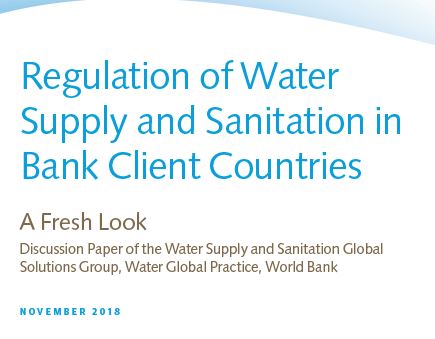Regulation of Water Supply and Sanitation in Bank Client Countries: A Fresh Look
This discussion paper is a supplement to the 2018 World Bank global study Aligning Institutions and Incentives for Sustainable Water Supply and Sanitation (WSS) Services, recently published by the World Bank’s Water Global Practice. The Global Study promotes holistic approaches in shaping WSS sector policies, institutions and regulation by considering the wider political economy and governance framework to incentivize sustainable actions. In particular, this paper examines how lower- and middle-income countries (LMICs)1 can successfully establish or improve regulation of the WSS sector by taking into account political, legal, and institutional realities. Rather than importing “best practice” models from OECD (or broadly, upper-income) countries, experience has emphasized the importance of developing “best fit” regulatory frameworks that are aligned with the policy and institutional frameworks of a LMIC’s WSS sector. This ensures that new regulations are embedded within the country’s broader political economy and governance frameworks. This paper does not seek to offer definitive conclusions, rather it provides suggestions on the way forward, along with a phased approach to regulatory reform. Importantly, it sheds light on the issues that warrant further investigation to determine the future of WSS regulation in LMICs. Background Regulation is a policy intervention that aims to promote sector goals in the public interest – balancing the competing interests of the various stakeholders. Economic regulation refers to the “setting, monitoring, enforcement and change in the allowed tariffs and service standards for utilities” (Groom et al., 2006). The United Kingdom and Australia both established independent regulators in the 1980s and 1990s as part of a package of reforms built around privatization or commercialization. Regulation of private utilities has existed for many decades in the United States, while contract regulation has historically predominated in France and Spain. These international reforms of WSS services often inspired similar models of regulation in LMICs. Yet, the context for regulation in LMICs was much different from where the models originated—in terms of access, quality of service, data availability, human capacity, governance and institutional context, to name a few. Regulatory initiatives in OECD countries were also built on foundations such as trusted institutions, well-defined property rights, and a formal system of contract and corporate law, creating predictability and stability for investors. In LMICs legal and administrative institutions are less developed, with weaker enforcement, transparency, and accountability, and local history, customs, and traditions that can play a significant role in determining reform outcomes. WSS Regulation in Low- and Middle-Income Countries For regulations to be effective, their goals, form, and function must align with the country’s established institutional framework, and consider the realities of its political economy. Otherwise, governments may merely create the illusion of reform. This is often described as “isomorphic mimicry,” referring to when governments suggest reform but do not necessarily implement it, for example by only making changes in the external form of policies and/or organization rather than their actual functions. Perhaps the biggest challenge to successfully importing regulation models from OECD countries to LMICs derives from significant differences in ownership and legal structures. WSS providers in LMICs are dominated by state-owned enterprises (SOEs) or are run by municipal governments, whereas private operators or ring-fenced corporatized SOEs dominate OECD countries. The incentive mechanism is quite different between public and private operators: • Private utilities. The ability of a private operator to finance itself and provide fair returns to shareholders is of critical importance. This provides private utilities with clear incentives to improve efficiency, deliver on improvements demanded by customers, and expand networks to new customers. • SOEs and municipal-run utility services. Financial sustainability is balanced with stated or unstated social and political objectives and weak accountability. Incentives are less clear and often lead to low levels of service quality, coverage, efficiency, and financial sustainability. Regulatory Objectives A government’s broader policy objectives determines what role regulation will play in achieving them, so gaining clarity on sector objectives is a critical first step. Policy objectives in OECD countries may be quite different from those in LMICs. In the former case, where universal coverage for the WSS sector already exists, the policy objective may relate more to efficient service delivery, environmental goals, and accessing commercial finance. In LMICs, the government’s objectives may be similar but prioritized in a different order, or else be completely unrelated. For example, some common regulatory objectives for the WSS sector in LMICs include: • Increasing access, especially to peri-urban and rural areas, and to poor and vulnerable groups; • Improving quality of service delivery; • Improving efficiency of service providers; and • Securing access to capital markets for sector financing.
